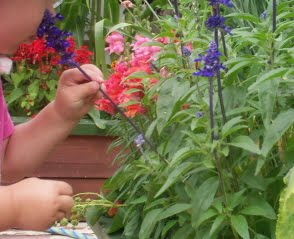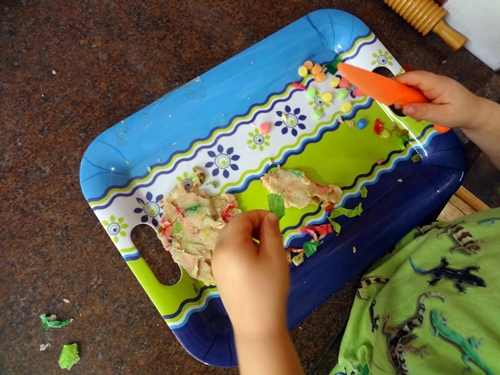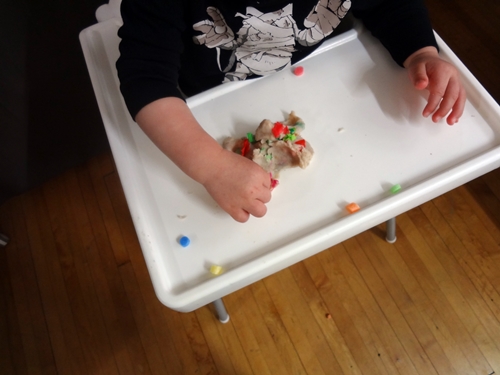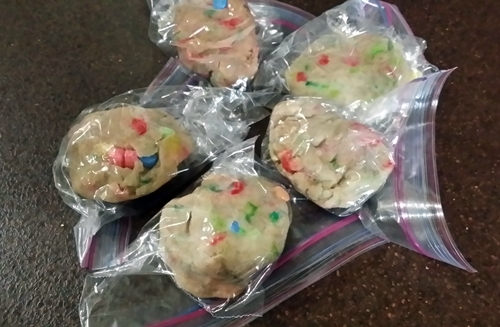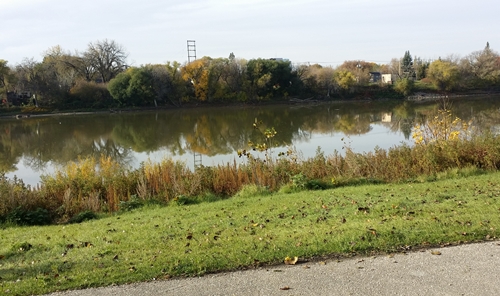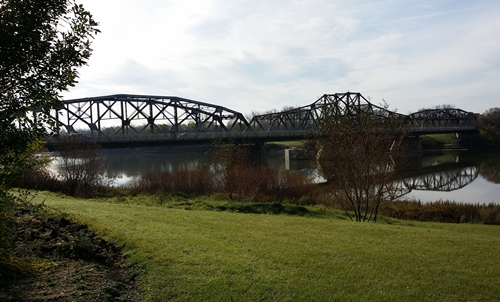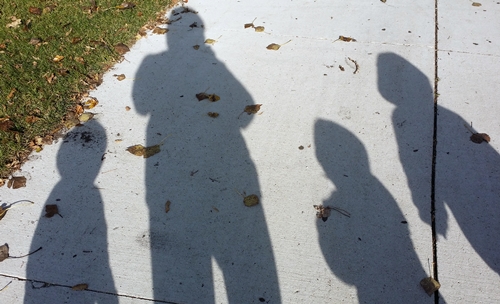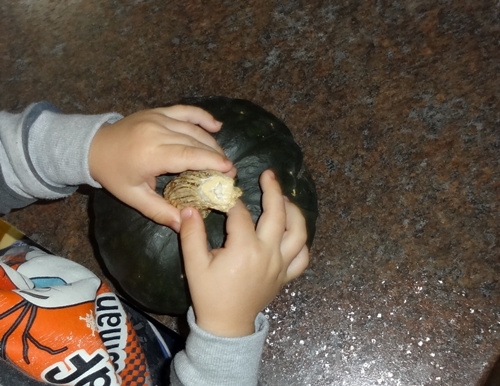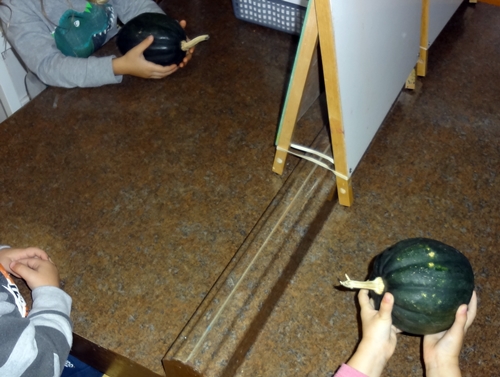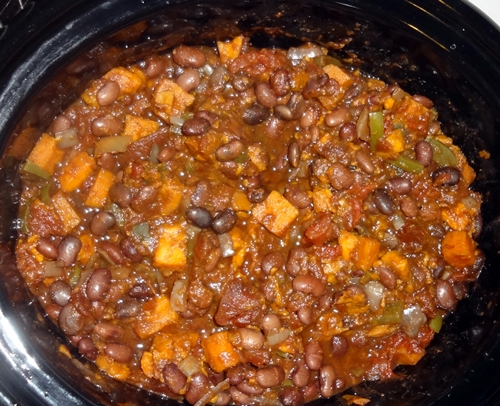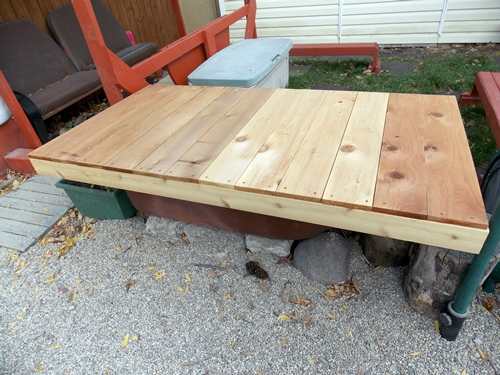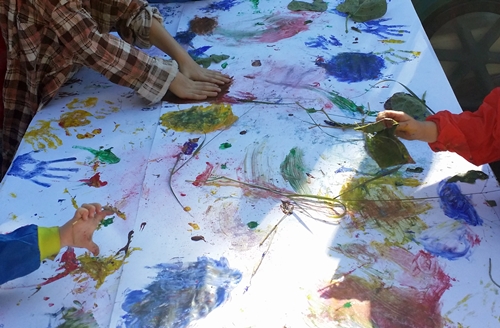The basic craft supplies are always available for the children to use
independently throughout the day – pencils, crayons, chalk, scissors,
glue, tape, rulers, magazines and various types of paper. The children’s
choice of paper is something that I find interesting. The current
school-age children go through vast amounts of plain white paper,
cutting pieces and gluing/taping them together to create books, masks
etc. They seem to have no interest in the coloured paper or adding
colour to their projects – unless there is paint.
The school-age children I had here for the summer preferred to use
the lined paper. They created impressive stories and art work filling
every space on one paper before selecting another piece of lined paper.
They never chose plain white paper or coloured paper.
For the preschoolers paper choice is a major decision often taking
more time than anything that they add to the paper. Coloured paper has
been their favourite ever since I showed them that the white
pencils/crayons were not ‘broken’, but you could only see them on darker
paper. If several of the preschoolers are at the table at the same time
the paper choice process takes even longer since they often rethink
their colour choice if the others pick a different colour.
Every time I restock the coloured paper the selection process is the
same. Pink paper is always the first choice and when all the pink paper
is gone they will choose purple. After that the decisions get more
difficult – light blue, dark blue, red or black get used up next but
they definitely are not the preferred colour choices. In fact, after
the pink and purple are gone they often choose plain white or lined
paper over the other coloured paper.
Eventually the stack of coloured paper contains only yellow, orange,
green, and brown. The preschoolers will occasionally use these colours
but they never seem pleased about it. So, as the sad looking four year
old sighed and reluctantly picked a yellow paper from the dwindling pile
I asked “Why don’t you like these colours?” She replied “I like them
but they are your favourites.”
?!?!?!
Yes, they are. Throughout all our activities we often discuss
favourite colours as well as other likes & dislikes but until she
mentioned it I had never even noticed that the ‘leftover’ paper pile
contained all my favourite colours. Awww, all this time have they been
leaving those papers for me? I always thought they picked pink and
purple first because they liked those colours best but now I’m wondering
if they chose them because they know I don’t like pink and purple.
They’re very perceptive.
Wednesday, October 28, 2015
Tuesday, October 20, 2015
Lumpy Dough
Play dough and other sensory materials are very popular with children
of all ages. I like play dough because unlike paint and many of our
other sensory activities there is little set-up time required for play
dough. I always have a batch of prepared play dough stored in my
refrigerator. The fact that it is cold at the beginning of the activity
and warm at the end is an added sensory experience.
The recipe I like to use most often is;
I do usually add some time of colouring to the dough and sometimes I add herbs, spices or some other scented material as well. I have plenty of tools to use with play dough – knives, scrapers, icing decorators, cookie cutters etc but I find that many of the children become so focused on tool ‘ownership’ that the play dough gets forgotten. Since this is a ‘process’ activity there is never a required product so I rarely offer tools unless the children specifically ask for them.
I chose not to add any colouring or scents to the latest batch of play dough. Instead, I started the activity by introducing foam ropes and tissue paper. The children then got to rip the tissue paper into tiny pieces and cut the foam rope – this was more challenging than I anticipated. The foam was so dense that none of the children’s knives could cut through it. Scissors worked but the cut pieces tended to fly everywhere – amusing to some of the children but annoying to anyone (me) trying to collect all the pieces.
The children then had the opportunity to mix the foam and paper into their dough – three very different textures.
Some chose to add their ‘decorations’ one at a time while others did so by the handful. Some used tools and played with their play dough as usual during the decorating process.
Interestingly several of them mixed the paper and foam pieces in the dough and then meticulously picked them all out and then mixed them in again. In fact, we have played with this dough several times since we first made it and ‘undecorating’ it has been a very popular activity – fantastic for fine motor skills.
By far my favourite response to this activity came from the school-age children. When they arrived after school and went to wash their hands for snack they saw the post-activity play dough on the counter. They were super excited about having ‘cookies’ for snack – followed by a little disappointment that it was just play dough.
The recipe I like to use most often is;
- 1 cup flour
- 1 cup water
- 1/2 cup salt
- 3 Tbsp cream of tartar
- 2 Tbsp vegetable oil
I do usually add some time of colouring to the dough and sometimes I add herbs, spices or some other scented material as well. I have plenty of tools to use with play dough – knives, scrapers, icing decorators, cookie cutters etc but I find that many of the children become so focused on tool ‘ownership’ that the play dough gets forgotten. Since this is a ‘process’ activity there is never a required product so I rarely offer tools unless the children specifically ask for them.
I chose not to add any colouring or scents to the latest batch of play dough. Instead, I started the activity by introducing foam ropes and tissue paper. The children then got to rip the tissue paper into tiny pieces and cut the foam rope – this was more challenging than I anticipated. The foam was so dense that none of the children’s knives could cut through it. Scissors worked but the cut pieces tended to fly everywhere – amusing to some of the children but annoying to anyone (me) trying to collect all the pieces.
The children then had the opportunity to mix the foam and paper into their dough – three very different textures.
Some chose to add their ‘decorations’ one at a time while others did so by the handful. Some used tools and played with their play dough as usual during the decorating process.
Interestingly several of them mixed the paper and foam pieces in the dough and then meticulously picked them all out and then mixed them in again. In fact, we have played with this dough several times since we first made it and ‘undecorating’ it has been a very popular activity – fantastic for fine motor skills.
By far my favourite response to this activity came from the school-age children. When they arrived after school and went to wash their hands for snack they saw the post-activity play dough on the counter. They were super excited about having ‘cookies’ for snack – followed by a little disappointment that it was just play dough.
Tuesday, October 13, 2015
A Lovely Autumn Hike
We have a new favourite park. I’ve passed it often in the car but
for some reason always thought it was too far away to take the children
hiking there. I failed to realize that it was really just a block
passed some of our other routes. Yes, it may be too far away for some
toddler groups but my current group has no problem with the distance.
The weather was wonderful on Friday – it was hard to believe it was October already. The park was quiet;
We headed to the bench. This was the halfway point of our planned route so it was the perfect place to take a break. It also offered a relaxing view of the river – the children all sat quietly, mesmerized by the scenery;
We met some new friends – they were wary but let us get fairly close;
The children got very excited when they saw a ‘new’ bridge. We have never walked over this one and wouldn’t today either but we got close;
We did stop by one of our other bridges on our way back but we couldn’t sit on the bench this time;
As we passed under the big bridge we listened to the echo as usual. One of the toddlers expressed concern that he couldn’t see our shadows anymore. We walked a little farther and there they were again – he insisted that I take a picture now that they were back;
It was a lovely Autumn hike in the city.
The weather was wonderful on Friday – it was hard to believe it was October already. The park was quiet;
We headed to the bench. This was the halfway point of our planned route so it was the perfect place to take a break. It also offered a relaxing view of the river – the children all sat quietly, mesmerized by the scenery;
We met some new friends – they were wary but let us get fairly close;
The children got very excited when they saw a ‘new’ bridge. We have never walked over this one and wouldn’t today either but we got close;
We did stop by one of our other bridges on our way back but we couldn’t sit on the bench this time;
As we passed under the big bridge we listened to the echo as usual. One of the toddlers expressed concern that he couldn’t see our shadows anymore. We walked a little farther and there they were again – he insisted that I take a picture now that they were back;
It was a lovely Autumn hike in the city.
Friday, October 9, 2015
Squash
I love how many different types of squash we get in our CSA share from Wild Earth Farms.
Each fall we collect some of the seeds from each of the different types of squash and try to grow our own plants in the spring. We can usually manage to get them to sprout and sometimes even move them to the outdoor garden but beyond that we haven’t been very successful.
The squash we get from the farm is very interesting. There are so many different sizes, shapes and colours. The textures of the stem, skin and innards are all so fascinating.
We compare the weight of the various sizes;
And of course we taste them too. All the muffin, cake and loaf recipes made with squash are very popular. The savory items are more challenging. Still, we try. They may never become permanent menu items but it is always fun to see what we can do with all our squash.
Slow-Cooker Vegetarian Chili
In a 4- to 6-quart slow cooker, combine the onion, bell pepper, garlic, chili powder, cumin, cocoa, cinnamon, 1 teaspoon salt, and ¼ teaspoon black pepper. Add the tomatoes (and their liquid), beans, squash, and 1 cup water. Cover and cook until the squash is tender and the chili has thickened, on low for 7 to 8 hours or on high for 4 to 5 hours. Serve the chili with the sour cream, scallions, radishes, and tortilla chips.
Each fall we collect some of the seeds from each of the different types of squash and try to grow our own plants in the spring. We can usually manage to get them to sprout and sometimes even move them to the outdoor garden but beyond that we haven’t been very successful.
The squash we get from the farm is very interesting. There are so many different sizes, shapes and colours. The textures of the stem, skin and innards are all so fascinating.
We compare the weight of the various sizes;
And of course we taste them too. All the muffin, cake and loaf recipes made with squash are very popular. The savory items are more challenging. Still, we try. They may never become permanent menu items but it is always fun to see what we can do with all our squash.
Slow-Cooker Vegetarian Chili
• 1 medium red onion, chopped
• 1 green bell pepper, chopped
• 4 garlic cloves, chopped
• 1 tablespoon chili powder
• 1 tablespoon ground cumin
• 2 teaspoons unsweetened cocoa powder
• 1/4 teaspoon ground cinnamon
• salt and pepper
• 1 28-ounce can diced tomatoes
• 1 15.5-ounce can black beans, rinsed
• 1 15.5-ounce can kidney beans, rinsed
• 1 medium squash, peeled and cut into 1⁄2-inch pieces
• sour cream, sliced scallions, sliced radishes, and tortilla chips, for serving
• 1 green bell pepper, chopped
• 4 garlic cloves, chopped
• 1 tablespoon chili powder
• 1 tablespoon ground cumin
• 2 teaspoons unsweetened cocoa powder
• 1/4 teaspoon ground cinnamon
• salt and pepper
• 1 28-ounce can diced tomatoes
• 1 15.5-ounce can black beans, rinsed
• 1 15.5-ounce can kidney beans, rinsed
• 1 medium squash, peeled and cut into 1⁄2-inch pieces
• sour cream, sliced scallions, sliced radishes, and tortilla chips, for serving
In a 4- to 6-quart slow cooker, combine the onion, bell pepper, garlic, chili powder, cumin, cocoa, cinnamon, 1 teaspoon salt, and ¼ teaspoon black pepper. Add the tomatoes (and their liquid), beans, squash, and 1 cup water. Cover and cook until the squash is tender and the chili has thickened, on low for 7 to 8 hours or on high for 4 to 5 hours. Serve the chili with the sour cream, scallions, radishes, and tortilla chips.
Monday, October 5, 2015
Walking & Talking
We've all
seen/heard them. Many of us know one personally. Some of us even have given birth to one of
our own. They are the high energy,
strong willed, emotionally intense children that challenge everyone and
everything.
When these children
are fully engaged in something they love to do it is magical to watch. It is a little scary too because if they are
interrupted or become frustrated or bored with the activity the magic may turn
to mayhem in a matter of seconds. They
are impatient and easily over stimulated.
In my current little
group of preschoolers I have three - yes three
of these 'difficult', 'spirited', whatever you want to call them, children.
Each one of these children is challenging but put all three of them
together for an extended period of time and things can become volatile very
quickly.
Even when, or
especially when they all have the same goal they struggle to cooperate - too
impulsive or competitive to work together they tend to destroy any progress
that another has made. Their own intense
reactions - happy, sad or mad - are further fuelled by the reactions of the
others. It is not that they purposely
want to disrupt activities but the reaction they get from the others is
exhilarating.
They all enjoy
active, gross motor play but it never seems to tire them out. In fact, like little crank-up flash lights,
the more energy an activity requires the more power they seem to build up. They seem to have better self control during
quiet activities but tension builds silently and will eventually explode.
Five hungry
children enjoying a peaceful lunch. A
single noodle slips off a spoon and plops back onto the plate. Splat!
That was a funny noise - someone giggles. Two children try to recreate that sound by
scooping and dumping spoonfuls of noodles.
Excitement and volume increase exponentially. Someone's milk gets knocked over and they
begin to cry. At this point lunch is
over. No amount of talking, redirecting
or reprimanding will return this situation back to a peaceful lunch.
Forget any type of
circle time activities. These children
love to talk. All of them have amazing
vocabularies but they don't seem to hear/understand anything anyone else says. It is far easier to get children to focus
when they are outside but even in a natural outdoor environment these children
will struggle with a group circle time activity. There is always someone on the other side of
the circle who is smiling, makes a silly face and waits for the reaction. Of course they get it - positive or negative
doesn't matter - it was a reaction.
This is why we
walk.
It is no secret
that I love to go hiking. Walking alone
through a forest is for me the most precious time. It is an introspective period of imagining,
reflecting, dreaming, discovering. I
often take children hiking but for each child/group of children the purpose of
the hike is different. For some it is
all about the destination. Others need
the exercise or the change of scenery.
This current group
of children is different. Their endless energy is never depleted - none of them
ever complain that they are tired of walking.
They are not concerned about our destination or the length of time it
may take us to get there. For this group
when we walk - we talk - and more importantly, we listen.
Maybe it is the motion
or the rhythm of our steps or the constant drone of the vehicles on the street
but as we walk these children and I have some of the most amazing
conversations. Conversations we have
never been able to have while sitting in a circle.
We talk about the
things we see. We tell stories about places
we have gone and things we have done. We
talk about our likes and dislikes. We
sing songs - together instead of competitively.
We take turns talking and sharing.
There are few interruptions and no pushing/grabbing/hitting because we
are busy walking. Sometimes we walk for
hours - they have a lot to say but it is hard for them to talk when there are
too many distractions. So we walk...and
talk.
Saturday, October 3, 2015
Yard Projects
As mentioned in my previous post there have been many small yard
projects I have tackled this summer. Several years ago we put our old
claw foot tub in the yard – re-purposed as a fire pit. It was placed as
a divider between the gravel area and the grass area but because of the
rounded shape of the tub it didn’t really prevent the gravel from
spilling over into the grass. Originally we just had a board that sat
just inside the tub to prevent access to the soot and debris but it
didn’t prevent rain from soaking the fire pit. Last year my husband
made a cedar cover for the tub.
It drives me crazy that he didn’t arrange the different coloured boards to create a pattern but I do love the smell of cedar so I try to focus on that instead. The tub cover makes a great table for many of our group activities like this one;
However it doesn’t do anything to prevent the gravel from spilling over into the grass. So, this summer I placed some cinder blocks along the cribbing beside the tub. They line up with the edge of the cover and as an added bonus they make a great surface for chalk drawings;
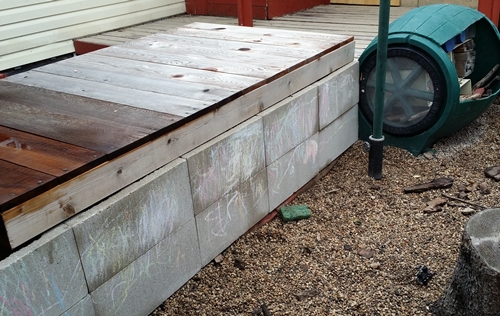
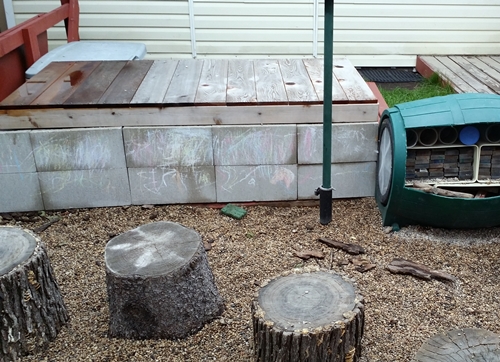
There was another issue with the tree stumps too. The children often like to use the stumps as tables – nothing wrong with that but it did sometimes get in the way of the children who wanted to walk on the stumps. Some of the children also didn’t like to sit on the gravel beside their ‘table’ but had trouble finding suitable items to use for chairs.
As mentioned in my last post, this summer I rearranged the stumps to create a circular path around and over the hill. I also had my husband cut a couple of the smaller stumps in half. These were then put on the other side of the yard in front of the tipi along with one of the biggest stumps to create this;
Since ‘the table’ is not part of the stump path dramatic play ‘meals’ don’t get in the way of active play. Yes, sometimes the children do like to climb on these stumps too and sometimes they still use other stumps as tables but at least now they have more options and fewer disputes.
It drives me crazy that he didn’t arrange the different coloured boards to create a pattern but I do love the smell of cedar so I try to focus on that instead. The tub cover makes a great table for many of our group activities like this one;
However it doesn’t do anything to prevent the gravel from spilling over into the grass. So, this summer I placed some cinder blocks along the cribbing beside the tub. They line up with the edge of the cover and as an added bonus they make a great surface for chalk drawings;


There was another issue with the tree stumps too. The children often like to use the stumps as tables – nothing wrong with that but it did sometimes get in the way of the children who wanted to walk on the stumps. Some of the children also didn’t like to sit on the gravel beside their ‘table’ but had trouble finding suitable items to use for chairs.
As mentioned in my last post, this summer I rearranged the stumps to create a circular path around and over the hill. I also had my husband cut a couple of the smaller stumps in half. These were then put on the other side of the yard in front of the tipi along with one of the biggest stumps to create this;
Since ‘the table’ is not part of the stump path dramatic play ‘meals’ don’t get in the way of active play. Yes, sometimes the children do like to climb on these stumps too and sometimes they still use other stumps as tables but at least now they have more options and fewer disputes.
Subscribe to:
Posts (Atom)
